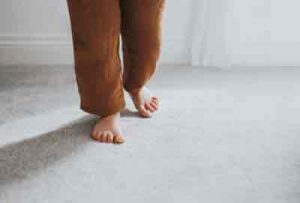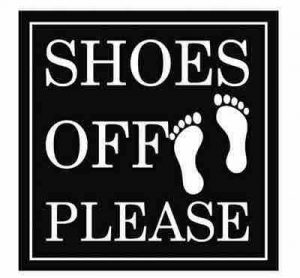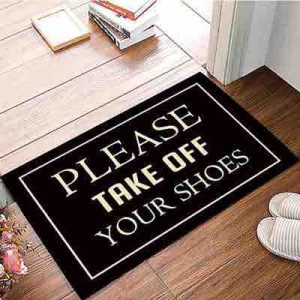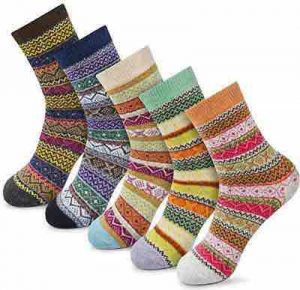If you want to make it convenient for guests to take off their shoes, you can do one of two things. You can make it easy for all your guests to take off their shoes; or hard for them not to.
Many modern houses and apartments have carpeted floors and minimal or no-shoes-allowed rules. It’s not only a matter of cleanliness but also comfort and safety.
There are a variety of ways that people do things, and it’s up to you and your family to decide what works best with your lifestyle and how you want to enforce a no-shoe policy in your home.
I have been doing some research online and have come up with some creative ways to impose a no-shoe policy without being too invasive or annoying.
Please note that these are just suggestions and not necessarily things I recommend trying at home.
If you want a policy that makes it easy for all your guests to take off their shoes, you need some creative no-shoe policy.
8 Creative Ways to Impose a No-Shoe Policy with Guests

- You can just ask in a polite manner
- Use a sign
- Get a cheeky welcome mat
- Ensure it is convenient for them to pull off their shoes
- Offer shoe alternatives like flip flops
- Ask the kids to help your guests with their shoes
- Use baskets
- Tell guests to bring socks
Ask in a polite manner
There are two main ways to implement a no-shoe policy in your home with your voice;
One is to just tell people. Try it. Say something like, “We don’t wear shoes in the house,” and see if that works for you. If it does, great! You’re done — everyone will know your rule and no one will forget it.
My home is my castle, and I want it to be shoe-free. But I don’t want to be a jerk about it.
I used to say: “Shoes…” It’s not abrupt, and some people would not need to argue for a while if they had to take off their shoes.
No one has ever refused. It’s true that someone might refuse if they were deeply offended by the idea of being asked.
If this approach doesn’t work for you, then maybe a sign is more your style. If you want to make your house a shoe-free zone, you can announce the new policy to guests by making a sign.
The sign doesn’t need much text; just the rules will do.
Use a sign

The sign pictured at right works well because it’s funny without being too weird. If you are concerned that your guests will be put off by having to read a sign or that they won’t understand it, write the rules out in a picture outside.
You can get a sign for your home that says, “Please remove shoes” or “No shoes allowed.” These signs are available at hardware stores and at some specialty gift stores.
To make an attractive no-shoe sign, cut a piece of plywood or heavy cardboard to 9 x 12 inches.
Paint the plywood or cardboard with acrylic craft paint in a color that coordinates with the room where you’ll display it.
On the board, measure and draw a rectangle 1 1/2 inches inside the border. Use painter’s tape to outline the rectangle.
Change Sign Color To complement your décor, try this:
Mix 1/2 cup white craft paint with 1/2 cup water in an ink bottle cap. Then mix in enough additional water to make one cup total. The mixture will be the consistency of milk.
Carefully pour this mixture into the rectangle on the back of your sign. It should cover the tape outline, but not run over onto the front side of your sign. Leave to dry overnight before using it.
Get a cheeky welcome mat

A welcome mat is a cheeky way of announcing that your house is a shoe-free zone. If people see the mat and decide to take their shoes off, good.
If they don’t, they will probably at least remember the idea of taking off their shoes.
A welcome mat takes only a few minutes to make. It is made from a piece of cork or rubber, which you glue down to a piece of wood or cardboard. You can buy cork or rubber online or at an arts and crafts store.
The best color for the wood is something light and neutral, so it doesn’t compete with whatever else you have on your front step. The “no shoes” symbol you can just draw with a marker.
You have to put the welcome mat someplace where people will walk on it, but not somewhere where it will get stepped on as soon as they come inside.
A good place might be just inside the door, the first thing someone sees when he comes in (but not the last thing he sees when he goes out).
The advantage of a welcome mat is that it’s easy to make and doesn’t cost much, but its value is in reminding people about taking off their shoes, not in actually doing it for them.
See these mats you can buy:
Ensure it is convenient for them to pull off their shoes
If you want to enforce a no-shoe policy in your house, you need to make it inconvenient for visitors to bring shoes into your house. Another is to make it inconvenient for them to take their shoes off once they are in your house.
The second strategy is friendlier, but the first is more effective. If you want to keep your house shoe-free, put shoe racks by the door.
If you don’t want to keep your house shoe-free, put an entryway rug down that makes it hard or impossible for guests to walk inside with shoes on.
People will not welcome your policy if you force them to do work; which is what taking off shoes does, before they can relax in your home.
But, if you make it easy for them to leave their shoes outside, they will be more likely to see your policy as something that makes their life easier rather than something that makes it harder.
Offer shoe alternatives

You could also offer alternatives like other indoor footwear: flip-flops, for instance, or slippers. If your guests aren’t likely to know the difference between these and indoor shoes, you’ll have to explain.
You might also want to put out a pair of indoor shoes next to the guest towels. If you’re feeling really bold, you could decide that wearing just socks is acceptable.
A rule that’s easy to remember and doesn’t involve nagging is “no bare feet.” But it has some problems: Many people feel self-conscious about their feet, so you might be uncomfortable saying anything about them.
If people start wearing socks and shoes indoors, they might not even notice when someone’s barefoot. That’s awkward.
How many people would be comfortable breaking this rule? Not many, probably. It’s not clear how much good it does even if everyone complies.
This approach works for some people, but it can also seem like an imposition, which it is. Slipper-socks are like socks with soft rubber soles that you wouldn’t want to wear outside.
The idea is that wearing them indoors makes taking your shoes off an act of politeness rather than an imposition.
Ask the kids for help
When guests arrive, have the kids show them where to put their shoes. This teaches the kids responsibility and helps them see that other people are part of the household, not just visitors.
And if you have kids who are not yet verbal, this is a great way to get them involved in helping out.
- One helpful thing is to make it clear to everyone that shoes should be taken off at the door. If you have a carpet, tell the family that they can’t leave dirt on it from their shoes. Of course, this means that you will need to vacuum throughout the day, but if your children are old enough, you can get them involved in this by making it into a game or chore. Be sure to keep an eye out for any telltale signs that someone has been tracking in dirt and then forgot to take off their shoes!
- Another way to enforce the rule is simply with the expectation that any time someone arrives with shoes on, they will take them off before entering your door — and once they’re inside, remember to remind them again!
- If you do use this method, I would recommend putting a basket or bin at the door so guests can set their shoes in until they go.
Use shoe baskets

We are so used to shoes being the most important object in our living rooms that it takes some effort to appreciate how arbitrary this is. There are other more interesting objects, some of which are quite portable.
I have found it helpful to have a shoe basket (like this one on Amazon) by the front door for guests’ shoes so that I don’t have to be tempted to wear them into the house.
People who live on their feet tend not to wear shoes into the house, but they do wear them out onto the lawns and sidewalks.
Often they are not wearing any socks under them, leaving their feet exposed. When you have visitors bring their own shoes in and put them in a basket, you never know when you will find a guest’s dirty, unmentionable foot resting on your clean couch cushions.
When we encourage guests to bring their own shoes and leave them in a basket by the door, we’re also creating a less-frequent opportunity for guests to meet our unmentionables.
They may well go out of their way to avoid such encounters, especially if they take shoes off at home and store them in a closet where they can’t be thrown away.
But, since we want guests to stay with us as long as possible, this kind of avoidance is probably not.
Tell guests to bring socks

If you are planning on having a shoe-free zone in your house, it is important to notify your guests when you send out the invitation. You can politely inform them that they should either bring or wear socks.
If you do not want to impose on your guests, you could decide to have shoes off only in certain areas of the house.
This is still an option for you if you want to encourage your guests to keep their shoes off. Just let them know of the designated areas of the house where they can take their shoes off.
It is also possible that certain people at the party might be prone to think that wearing shoes is appropriate.
Instead of inviting everyone, why not just invite people who will understand and comply with what you are asking?
You may want to decorate the party area with rugs or mats that will make it easier for people to take their shoes off.
It is also fun if you use decorative socks or socks that go with some theme of the party like one with polka dots for a polka dot-themed party.
Final words
No one has to go out of their way to prove they’re a good host by making some huge sacrifice for the comfort of their guests.
And if you have guests that are too sensitive about their own feet, then just ask them to bring indoor footwear with them.
That way your guests don’t have to make the choice between being comfortable and being polite.
Or make them feel bad for not bringing indoor footwear with them, even though it’s your house and your rule.
If you don’t want visitors to wear shoes in your house, make sure you have an alternative they can use.
A shoe rack with baskets for different kinds of indoor footwear, each with a pair of slippers at the bottom, is a nice touch. Or just offer some slippers that they can use.
This page may contain affiliate links.
To support the content and the knowledge I share here, I earn from qualifying purchases from Amazon at no extra cost to you.
